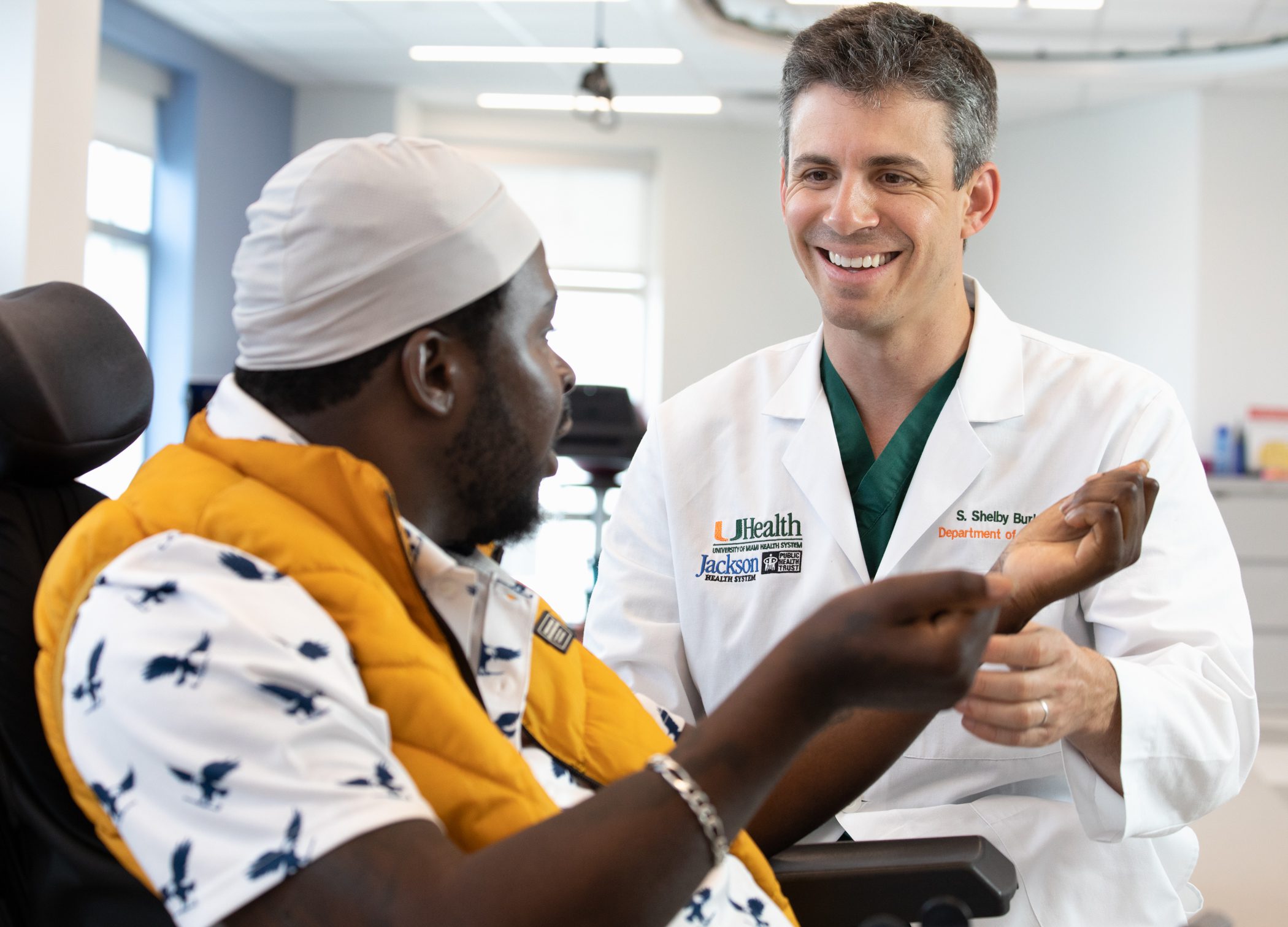S. Shelby Burks, M.D., Assistant Professor of Clinical Neurosurgery at the Miller School of Medicine Department of Neurological Surgery and The Miami Project to Cure Paralysis, was recently awarded Department of Defense (DOD) funding for a project titled “The Efficacy of Spinal Accessary Nerve Transfer Surgery in the Treatment of Patients with High Tetraplegia.” The award expands on an ongoing series of federally funded peripheral nerve studies at the Miller School combining surgery, regeneration, and rehabilitation to recover function after paralysis.
Hand function is consistently ranked as the most desired function to regain in the case of paralysis from spinal cord injury (SCI), even above that of bowel and bladder. It stands to reason—with approximately half of SCI occurring in the cervical spine—that Miami Project scientific efforts have been aimed at recovery of upper extremity function. Dr. Burks, a burgeoning academic neurosurgeon under Miami Project Clinical Director Allan D. Levi, M.D., Ph.D., is our site Principal Investigator on a series of new multi-center studies funded by the DOD’s Congressionally Directed Medical Research Program (CDMRP) mechanism. The studies examine the effect of nerve transfers with rehabilitation on reaching and grasping function, and quality of life, in people with tetraplegia.
Traumatic SCI, defined as an injury caused by physical insult to the nerves within the spinal cord, interrupts signals traveling through the central nervous system. In many cases, however, the nerves that exit the spine at nerve root, located below the level of injury are still capable of conducting or transmitting signals. The problem with these nerves is input, not transmission. It has long been established that peripheral nerve axons have the capacity to naturally regenerate—unlike their central nervous system counterparts that will require external modification to do so. Combined, surgeons have realized that peripheral nerves originating from roots above the injury can be cut, repositioned, and then fixed into a different peripheral nerve that arises from below the level of injury. This nerve transfer allows for the signal generated by a nerve supplied at a higher level above the injury to be transferred down the nerve normally supplied by a lower level below the injury.
Although peripheral nerve transfer is not an experimental procedure—a person with cervical SCI can solicit their local neurosurgeon for a peripheral nerve transfer as a standard of their care—thus far a definitive research effort has yet to establish a robust and generalizable profile of the therapeutic approach. We know that the central nervous system, particularly the spinal cord, is uniquely challenging when it comes to inducing regeneration. The peripheral nerve transfer being studied in these trials circumvents the issue. The approach is possible because above the injury, the spinal cord is completely intact, while below the injury, the peripheral nerves are also still capable of sending signals down their axons. Therefore, reattaching a nerve from above the injury, which has seemingly redundant function to the otherwise latent nerve below the injury allows for existing signals to be rerouted to activate previously paralyzed muscles. With targeted motor relearning, the restored signals to sublesional muscles could increase the quality of life of people with SCI.
The clinical rational is clear, illustrating why nerve transfer surgeries, especially those to treat brachial plexus and peripheral nerve injuries, have become increasingly popular in the last 25 years. However, only recently have nerve transfer surgeries been considered as potential treatment options for patients with cervical SCI. Therefore, while the surgical approach is well understood, the series of studies being led at the Miller School by Dr. Burks aim to establish a generalizable profile of the outcomes of peripheral nerve transfer for upper extremity motor strength in people with tetraplegia. Success will result in broadening the evidence base for the clinical benefits of cervical nerve transfer in tetraplegia, mainstreaming the approach thereby boosting access to this therapeutic to benefit function and quality of life of people with cervical SCI.
This series of multi-site studies, to mainstream peripheral nerve transfer for tetraplegia, are headed by Dr. Wilzon Z. Ray, M.D., at Washington University School of Medicine. Across the studies, between four and eight sites in the United States and Canada with The Miami Project’s efforts lead by Dr. Burks. The series began with a trial for people with SCI in the mid- to lower- (further from the head) cervical region, with a study registered with the U.S. National Library of Medicine under the identifier NCT04023591.
The recent additional, yet operationally separate, CDMRP funding allows Dr. Burks to apply the surgical approach to people with SCI in the high-cervical region, at or above the fourth cervical vertebra. These funded studies will run in parallel and are either actively recruiting or in the pre-recruitment startup phase. Together these studies demonstrate how clinician-scientists like Dr. Burks dynamically employ multi-pronged research approaches to advance medicine for people in kind, in this case those living with paralysis.

